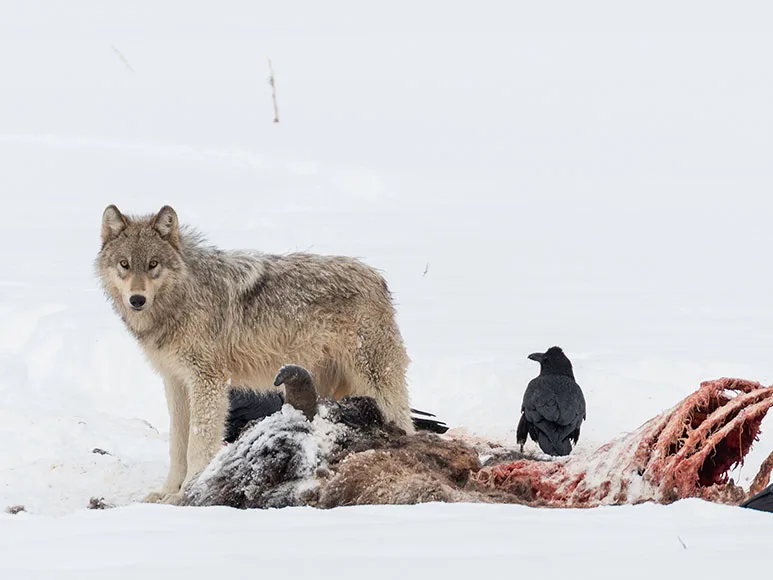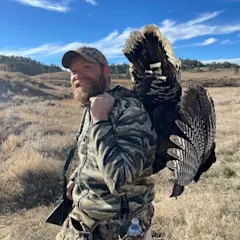A series of wolf-related bills have caused a stir at the Montana Statehouse this legislative session. While one bill that would have created a year-round open season on wolf hunting and trapping has been abandoned, another that aims to reduce the state’s wolf population by more than half passed the House and is headed to the Senate. Proponents hope the bill will bring perpetually high wolf numbers to heel, sparing ungulate and livestock populations that the animals prey on. Critics say it amounts to little more than “ballot box biology.”
Montana's current wolf hunting season runs from early September to mid-March. The first half of the season (Sept. 2 to 14) is archery-only while the second half (Sept. 15 to March 15) is a general season open to firearm use. The current trapping season runs from Jan. 1 to Feb. 15 in regions 1 through 5 and Dec. 2 to March 15 in regions 6 and 7. Each region has separate quotas that add up to 334 wolves per year statewide. There are also two Wolf Management Units with their own set of regulations on land bordering Yellowstone National Park.
House Bill 222 would have tossed that system out and replaced it with year-round hunting and trapping that only shuts down if an annual quota of 600 wolves is reached. Current FWP estimates put Montana's overall wolf population somewhere in the neighborhood of 1,100 animals.
Montana Fish Wildlife & Parks publicly opposed HB222 with the agency's Chief of Conservation Policy Quentin Kujala speaking out against the measure on the House floor. “This bill ... remov[es] all flexibility requiring an inflexible hunting season for wolves and unlimited quota year-round,” Kujala said at the podium, as reported by the Missoula Current. “The other piece we point to is the insertion of potential undocumented mortality of pups in the den. That would represent a change in circumstance that would take some time for us to sync (the population model) to.”
Members of the hunting community also came out against HB222. "The commission manages wildlife throughout the state based on the best science available. We set quotas based on what the science says, and we set those numbers at the district level," said Backcountry Hunters & Anglers (BHA) Montana Chapter member Matt Leo during the hearing. "This uses a sledgehammer approach instead of a scalpel." Ultimately, the bill died in the House, receiving a total of 40 yes votes and 60 no's.
HB176 is a different and slightly less controversial wolf bill, also originating in the Montana House of Representatives. In its original form, it would have forced FWP to scrap the current statewide wolf quota of 334 animals. Instead, the state agency would have to implement an unlimited quota, at least until the population dipped to a total of 450 wolves. According to FWP, the U.S. Fish & Wildlife Service requires Montana to maintain a population of at least 150, wolves with 15 breeding pair, to keep the animals off the Endangered Species List.
Before it was voted on, the 450 wolf population target in BH176 was changed to a goal of 550 wolves statewide. Then, an eleventh amendment changed the bill's language. The text went from "requiring" FWP to make the proposed quota changes to "allowing" the agency to do so if it sees fit.
Some proponents were disappointed with the outcome, saying the amendment took the bill's teeth away. “Unfortunately, [it] really ... gutted the bill,” Rep. Jedediah Hinkle, a Republican from Belgrade told the Missoula Current. “But the point is that, so far, the commission has not been setting these quotas to allow the wolf number to drop. So let it be known - legislative intent - we want the commission to set the quotas in the state so these numbers can start dropping down.”
Democratic Rep. Marilyn Marler—a hunter from Missoula who's advocated for hunter-related issues in the past, including the re-introduction of in-person hunter education courses in Montana—said she opposed even the amended version of the bill—largely because of its optics. "This is a partisan issue at this point,” Marler said. “This bill maybe won’t do anything (destructive) but it sure looks gross from a sportsman’s point of view.”
Read Next: Montana Bill Would Require License Fees for All Shed Hunters
Other critics say the legislature's recent wolf measures have nothing to do with sound wildlife management. "As hunters we decry ballot box biology all the time, and that's exactly what this is," Missoula hunter Corey Ellis tells Field & Stream. Ellis used to co-chair Montana BHA, and he's worked with Orion the Hunter's Institute, a Montana-based organization devoted to fair chase ethics. "These politicians are just pandering to constituents—not actually trying to get anything done," he added. "These kinds of things should be left to [Montana Fish, Wildlife & Parks] and the commission to decide. Wildlife management should be the realm of biologists not legislators."


